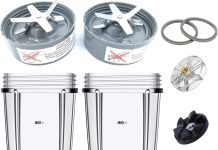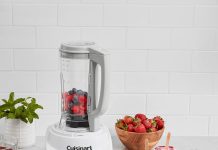Imagine never having to spend hours scrubbing and washing your juicer parts again. With dishwasher-safe juicer parts, you can breeze through the cleaning process and enjoy your freshly squeezed juice without the hassle. Say goodbye to sticky residue and stubborn stains, and say hello to convenience and easy maintenance. By investing in a juicer with dishwasher-safe parts, you can save time and effort, allowing you to focus on what really matters – enjoying a healthy and refreshing start to your day.
Review contents
Why Choose a Dishwasher-Safe Juicer?
Convenience and Time-Saving
Choosing a dishwasher-safe juicer can significantly improve your juicing experience by offering convenience and saving you precious time. With dishwasher-safe juicer parts, you can simply disassemble your juicer after use and place the removable parts directly in the dishwasher. This eliminates the need for manual scrubbing and tedious handwashing, allowing you to focus on other tasks while the dishwasher takes care of the cleaning. The time saved can be especially valuable during busy mornings or when hosting guests.
Thorough Cleaning
Having dishwasher-safe parts ensures a thorough cleaning of your juicer. The high temperatures and powerful jets of water in a dishwasher can effectively remove stubborn stains, pulp residue, and even bacteria that may be present on your juicer components. This level of cleanliness may be challenging to achieve through manual washing alone, making dishwasher-safe juicers an ideal choice for those who prioritize hygiene.
Avoiding Cross-Contamination
Cross-contamination is a concern when it comes to juicers. Different fruits and vegetables can harbor bacteria or allergens, and if not properly cleaned, these particles can transfer to your next batch of juice. Dishwasher-safe juicer parts provide a reliable solution to mitigate the risk of cross-contamination. The hot water from the dishwasher helps eliminate any potential traces of previous juicing sessions, ensuring that each new juice is fresh and free from unwanted contaminants.
Types of Juicers with Dishwasher-Safe Parts
Centrifugal Juicers
Centrifugal juicers are known for their high-speed spinning action that extracts juice quickly. Many centrifugal juicers come with dishwasher-safe parts, making them easy to clean after use. These parts typically include the pulp container, juice collector, and food pusher. The rapid juicing process of centrifugal juicers can often result in more pulp residue, necessitating thorough cleaning. Luckily, the dishwasher-safe parts alleviate this concern and make the cleaning process effortless.
Masticating Juicers
Masticating or slow juicers are known for their ability to extract juice from fruits and vegetables with minimal oxidation, resulting in higher-quality juice and longer shelf life. While masticating juicers may have more intricate parts compared to centrifugal juicers, certain models offer dishwasher-safe components. These parts may include the auger, juicing screen, and juice collection containers. The convenience of dishwasher-safe parts for masticating juicers allows you to enjoy the benefits of slower juicing without the hassle of labor-intensive cleaning.
Citrus Juicers
Citrus juicers are specifically designed for juicing oranges, lemons, limes, and other citrus fruits. Many citrus juicers feature dishwasher-safe parts, such as the reamer, juice container, and pulp filter. Given the sticky nature of citrus fruits, a dishwasher-safe design ensures that you can easily remove any residue or pulp left behind. This makes cleaning up after your refreshing glass of citrus juice a breeze.
Features of Dishwasher-Safe Juicers
Removable Parts
Dishwasher-safe juicers are equipped with removable parts that can be conveniently disassembled and placed in the dishwasher. These parts may include the pulp container, juice collector, feeding chute, plunger, and various attachments depending on the type of juicer. Removable parts make the cleaning process quick and efficient, allowing you to spend more time enjoying your freshly extracted juice.
BPA-Free Materials
Bisphenol A (BPA) is a chemical commonly found in certain plastics and can potentially leach into food and beverages, posing health risks. When choosing a dishwasher-safe juicer, opt for models made from BPA-free materials to ensure the safety and purity of your juice. Manufacturers of dishwasher-safe juicers often prioritize the use of BPA-free plastics, stainless steel, or glass for the removable parts that come into direct contact with your produce.
Ease of Assembly
In addition to being dishwasher safe, juicers with easily assembled parts provide added convenience. Nobody wants to spend excessive time trying to figure out how to put their juicer back together after cleaning. Manufacturers of dishwasher-safe juicers often design their products with user-friendly assembly mechanisms, allowing you to quickly reassemble the cleaned parts and get back to juicing in no time.
Tips for Cleaning Dishwasher-Safe Juicer Parts
Disassembling the Juicer
Before cleaning your dishwasher-safe juicer parts, it is crucial to properly disassemble the juicer. Refer to the manufacturer’s instructions to ensure that you remove all detachable components correctly. Typically, this entails removing the pulp container, juice collector, feeding chute, juicing screen, blades, and any other removable parts. Take care to handle fragile parts with caution to avoid any breakage.
Rinsing Off the Residue
After disassembling the juicer, rinse off any visible residue or pulp from the parts using running tap water. This initial rinse helps remove larger particles and prevents them from sticking during the dishwasher cycle. Use a soft brush or sponge to gently scrub any stubborn residue that may be clinging to the parts. This preliminary rinsing step contributes to a more effective cleaning cycle in the dishwasher.
Using the Right Detergent
Choosing an appropriate dishwasher detergent is essential to ensure the cleanliness of your juicer parts. Opt for a dishwasher detergent that effectively removes grease and food particles while being gentle on your dishwasher-safe components. Avoid abrasive or overly harsh detergents, as they may damage the plastic parts of your juicer. Consult the detergent manufacturer’s instructions for the optimal usage amount.
Precautions and Considerations for Dishwasher-Safe Juicer Parts
Temperature and Heat Resistance
Before placing your juicer parts in the dishwasher, verify that they are heat-resistant and suitable for high temperatures. Exposing non-heat-resistant materials to the high heat of the dishwasher can cause warping, discoloration, or even melting. Refer to the user manual or contact the manufacturer to determine the dishwasher temperature limits for your specific juicer parts.
Fragile Parts
Some juicer parts, such as juicing screens or augers, may be delicate and prone to damage. Take extra care when handling these fragile components to prevent any breakage. If dishwasher-safe juicer parts are delicate, it may be recommended to handwash them instead of subjecting them to the potentially forceful water jets in the dishwasher. Always refer to the manufacturer’s instructions for specific recommendations regarding fragile parts.
Frequency of Dishwasher Use
Consider the frequency of dishwasher use when deciding on a dishwasher-safe juicer. If you use your dishwasher regularly, opting for a juicer with dishwasher-safe parts may be a convenient choice. However, if you rarely use your dishwasher, the dishwasher-safe feature may be less important, and you may choose a juicer with other desirable features.
When Dishwasher-Safe Parts Are Not Available
Handwashing the Juicer
If you have a juicer that does not have dishwasher-safe parts, you can still clean it effectively by handwashing. Disassemble the juicer and rinse off any residue under running water. Use a soft brush or sponge to gently scrub all surfaces to remove any traces of pulp or juice. Pay close attention to crevices and hard-to-reach areas. Rinse all parts thoroughly and allow them to air dry before reassembling your juicer.
Cleaning Methods and Tools
There are various cleaning methods and tools that can assist you in maintaining the cleanliness of your juicer. Some juicer manufacturers provide specialized cleaning brushes specifically designed for removing pulp or residue from blades, screens, or filters. Additionally, you can use citric acid, white vinegar, or baking soda to tackle stubborn stains or odors. Soaking the parts in a solution of warm water and any of these agents can help loosen any remaining residue.
Common Mistakes to Avoid When Cleaning Dishwasher-Safe Juicer Parts
Leaving Parts to Soak for Too Long
While soaking juicer parts can help loosen residue, leaving them submerged for extended periods can lead to discoloration or damage. Avoid soaking dishwasher-safe juicer parts for prolonged periods, especially if they contain fragile materials. Instead, try to clean the components immediately after use or within a reasonable timeframe to maintain their integrity.
Using Abrasive Materials
When cleaning your dishwasher-safe juicer parts, avoid using abrasive materials such as steel wool or harsh scrub brushes. These abrasive tools can scratch or damage the surface of your juicer components, compromising their cleanliness and functionality. Opt for softer brushes or sponges to avoid any potential harm to your juicer.
Improper Drying
After cleaning your dishwasher-safe juicer parts, ensure they are thoroughly dried before reassembling or storing them. Moisture can promote the growth of mold or mildew, compromising the cleanliness of your juicer. Allow all parts to air dry completely or use a soft cloth to remove excess water. Proper drying helps maintain the longevity of your dishwasher-safe juicer parts.
Recommended Dishwasher-Safe Juicer Brands
Brand A
Brand A offers a range of juicers that feature dishwasher-safe parts, ensuring easy cleaning and convenience. Their models include both centrifugal and masticating juicers, providing options for various juicing preferences. Brand A focuses on customer satisfaction and innovative design, making them a reliable choice for those seeking a dishwasher-safe juicer.
Brand B
Brand B is known for its commitment to producing high-quality juicers that offer dishwasher-safe parts. With a reputation for durability and performance, their juicers make cleaning a breeze. Brand B’s dishwasher-safe juicers come in sleek designs and incorporate advanced technology for efficient and effective juicing.
Brand C
When it comes to dishwasher-safe juicers, Brand C stands out with its emphasis on user-friendly features and ease of cleaning. Their juicers are designed with detachable parts that can be safely cleaned in a dishwasher, providing utmost convenience. Brand C’s juicers are known for their durability and are highly regarded by juicing enthusiasts.
Cost Comparison of Dishwasher-Safe Juicers
Entry-level Juicers
Entry-level dishwasher-safe juicers are commonly priced between $50 and $100. These juicers offer basic functionalities and are suitable for those new to juicing or on a limited budget. While they may lack advanced features, they still provide the convenience of dishwasher-safe parts.
Mid-range Juicers
Mid-range dishwasher-safe juicers typically range from $100 to $300. These juicers offer a balance between affordability and enhanced features. They often have more powerful motors, greater juicing efficiency, and improved durability. Investing in a mid-range dishwasher-safe juicer can provide a satisfactory juicing experience without breaking the bank.
High-end Juicers
High-end dishwasher-safe juicers can cost upwards of $300. These juicers are designed for avid juicers and professionals who prioritize top-notch performance and longevity. They often feature advanced technologies, multiple speed settings, and premium build quality. High-end dishwasher-safe juicers ensure a superior juicing experience and are built to last.
Frequently Asked Questions about Dishwasher-Safe Juicer Parts
Can all juicer parts be cleaned in a dishwasher?
Not all juicer parts are dishwasher safe. Certain delicate parts, such as juicing screens or augers, may require special care and handwashing. Always refer to the manufacturer’s instructions or website to determine which specific parts are dishwasher safe and which should be cleaned manually.
How long does it take to clean juicer parts in a dishwasher?
The time it takes to clean juicer parts in a dishwasher can vary depending on the dishwasher’s cycle length and the complexity of the juicer parts. Generally, a standard dishwasher cycle takes around 2-3 hours. However, the cleaning time for juicer parts can be significantly shorter, typically around 30 minutes to an hour.
Is it safe to clean electronic juicer parts in a dishwasher?
The safety of cleaning electronic juicer parts in a dishwasher depends on the manufacturer’s guidelines. While some electronic juicer parts may be dishwasher safe, others should be cleaned manually to avoid damage to sensitive components. Always consult the user manual or contact the manufacturer to determine the dishwasher compatibility of electronic juicer parts.






























